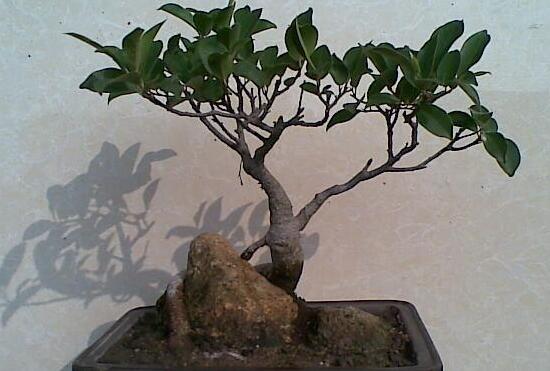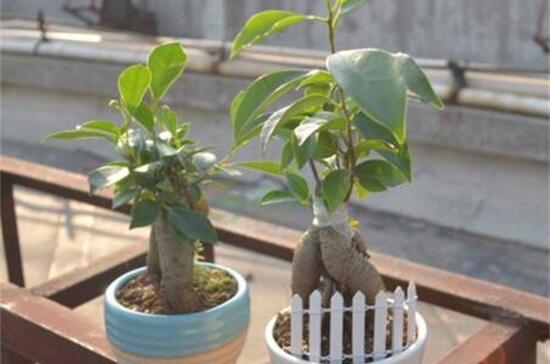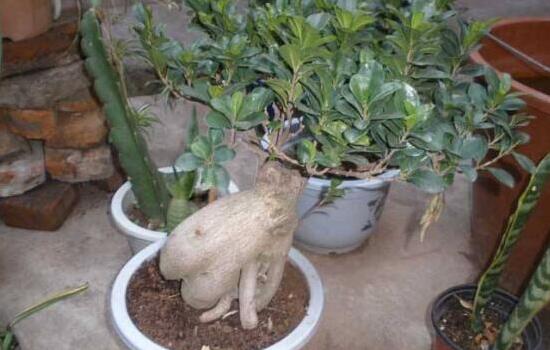How long does ginseng banyan fertilize and how long water? How to fertilize and propagate ginseng banyan? what about the yellowing leaves?
Ginseng banyan, named for its long roots like ginseng, is an ornamental plant suitable for indoor culture. It can be said that it is very simple to feed ginseng banyan, but it is not easy to want the beauty of ginseng banyan growth, especially watering and fertilizing. Before we know how to water ginseng banyan, that ginseng banyan how to fertilize? Let's go with the editor to take a look at the fertilization method of ginseng banyan.
1. How to fertilize ginseng banyan, time / fertilizer species / skills

"A flower in a crop depends entirely on fertilizer." although ginseng banyan does not have high requirements for fertilizer, if it wants to grow well, the right amount of fertilizer is very important. Because the plant will die when the wrong fertilization is serious, so how to apply fertilizer to ginseng banyan requires us to strictly grasp the time, fertilizer species and fertilization skills.
2. The fertilization methods of ginseng banyan are as follows.
(1) how often does ginseng banyan fertilize?
Because ginseng banyan does not have high requirements for fertilizer, we must pay attention to the time of fertilizing it:
1. Ginseng banyan, which has just been bought or changed, should not be fertilized. At this time, the plant is still in the stage of adaptation and should not absorb fertilizer.
2. Fertilization is usually in spring and autumn, which is the growing period of ginseng banyan. You can keep fertilizing once a month.
3. Ginseng banyan should be changed every 2 years in spring. However, after changing the basin, you must wait for the temperature to rise above 20 ℃ before fertilizing.
(2) what kind of fertilizer is used for ginseng banyan?
In the process of cultivating ginseng banyan, many flower lovers want to know what kind of fertilizer ginseng banyan uses. In this regard, the editor suggests that everyone should use fertilizers, mainly nitrogen, phosphorus and potassium, and apply them once a month during the growing period, 3-4 times a year. It should be noted that the proportion of nitrogen, phosphorus and potassium fertilizer should be applied, otherwise the leaves of ginseng and banyan will turn yellow.
(3) fertilization tips
1. When fertilizing ginseng banyan, you can bury the fertilizer in the soil. Do not come into direct contact with the root to avoid fertilizer burning the root.
2. When applying fertilizer, the fertilizer can be turned into fertilizer and water, and then irrigated around the basin wall. Pay attention to the fertilizer can not be spilled on the leaves, and the fertilizer can not be too thick, otherwise it will cause ginseng banyan growth.
(4) how to apply too much fertilizer to ginseng banyan and dilute it by irrigation?
For beginners, when fertilizing ginseng banyan, there is often too much fertilizer, so what should we do at this time? At this time, everyone should water the ginseng banyan thoroughly and let the current bring out the chemical fertilizer; at the same time, move the plant to a ventilated shade and let it recover slowly, and do not start fertilizing until the temperature is above 20 ℃.
With regard to the fertilization method of ginseng banyan, the editor has introduced this. After reading it, everyone should have more confidence in raising ginseng banyan. Generally speaking, the culture method of ginseng banyan is not difficult, but it is difficult in some details, whether it is watering or fertilization, it must be in the right amount, neither more nor less. Only in this way can you raise a beautiful pot of ginseng banyan!
How to fertilize ginseng banyan
The time and method of fertilization of ginseng banyan:
In fact, ginseng banyan is not good fertilizer, so the simple way is to apply compound fertilizer to it every season, but the fertilizer should be mainly nitrogen, phosphorus and potash fertilizer, which can be guaranteed 3 to 4 times a year. Avoid too much fertilizer, which will cause the overgrowth of the plant and affect its overall shape.
During its growth period, fertilizer can be applied once a month, mainly phosphate fertilizer and potassium fertilizer, as long as the fertilizer is buried in the soil, but do not come into direct contact with the root to avoid fertilizer burning the root.
Matters needing attention in fertilization of ginseng banyan:
The newly purchased ginseng banyan needs time to adapt to the new environment, so there is often the phenomenon of losing leaves. Friends do not have to worry about it. At this time, it does not need any nutrients, and you have to wait until it takes the pot thoroughly before fertilizing.
When changing pots for ginseng banyan, it is usually carried out in spring, so after changing pots, you must wait until the temperature rises to more than 20 degrees before fertilizing.
Problems arising from too much or too little fertilization and their solutions:
If you apply too much fertilizer, especially when there is too much nitrogen fertilizer and less phosphate and potassium fertilizer, it is easy to cause the leaves of the plant to turn yellow. At this time, you should pour a lot of water and let the fertilizer be discharged along with the water, and then you need to remove half of the soil in the basin and replace it with new soil.
If there is too little fertilization, especially if there is no application of nitrogen fertilizer for a long time, it is easy to cause the branches and leaves of the plant to shrink, and the leaves will turn yellow. at this time, they should all be replaced with new and fertile soil, replanted and watered and moved to a cool place for maintenance.
Propagation methods of potted ginseng banyan how to raise ginseng banyan
Ginseng banyan, which is cultivated from the seedlings of Ficus microphylla, is an evergreen tree plant of the genus Ficus of Moraceae. its potted plants have been transplanted to various parts of the world, with roots shaped like ginseng, natural shape, exposed root plate, beautiful crown and unique charm. It is interesting and enjoyable, and is deeply loved by consumers all over the world. Let's take a look at how potted ginseng banyan is cultivated.
Growth habits of ginseng banyan
The vitality of ginseng banyan is amazing. It can grow in any environment and any soil, and can even be attached to stones or retaining walls. Salt-resistant, light-loving and warm and humid climate, water and moisture resistance. It grows slowly and has a broad and dense crown and branches. The growth temperature is 1833 degrees, not less than 10 degrees in winter, and it is easy to suffer frost damage if it is lower than 6 degrees. Sex likes a warm and humid environment. It can be placed in places with proper light in spring and autumn and in places without direct sunlight in summer. Watering should be dry and wet, and the basin soil should always be kept moist.
Propagation methods of ginseng banyan
1. Sowing: ginseng and banyan should be sowed along with seed collection, treatment and sowing. First wrap the ripe berries with cotton gauze, scrub and wash them into a dilapidated shape in clean water, then sow them directly in the finished sand bed or flowerpot after drying for 2 or 3 days, remove the sowing, do not cover the soil, spray clean water once or twice a day, and keep the bed moist. Under the condition of 25-30 ℃, it sprouted one after another 10 days after sowing.
2. Cuttage: when a large number of seedlings are raised in South and Southwest China, tender wood cuttings are often carried out on the open-field nursery bed in the rainy season, and the survival rate is more than 95%. In the north, one-year-old full branches can be picked in early May and cut in flowerpots, wooden boxes or seedbeds. Cut the branches according to 3 sections, keep the first 1-2 leaves, insert them into plain sandy soil, protect them from shade, spray water once or twice a day to improve air humidity, pay attention to windproof, and take root one after another after 20 days.
3. Striping: in order to cultivate large seedlings, ginseng banyan can be pressed by making use of the soft characteristics of big branches. First put a large flowerpot near the mother plant and install the potted soil, then choose a large side branch with good shape to bend down and bury the flowerpot, and press it with stones, the human-soil part can take root without being scratched, and it can be cut off from the mother body 2 months later to form a larger potted plant.
How to raise potted ginseng banyan?
1. Soil: the bonsai culture of ginseng banyan is best cultivated in river sand or sandy soil. in order to make the root of ginseng banyan big and fat, a little fertilizer should be added, which can be added with a higher proportion of phosphorus and potassium fertilizer. When cultivating ginseng banyan, be sure to use seeds to sow seeds in order to grow fat roots.
2. Temperature: the best growth temperature of ginseng banyan is between 18 and 33 degrees Celsius, so we should pay attention to sun protection and frost protection in winter and summer, especially in winter, the temperature should not be too low, otherwise the fallen leaves are small and may freeze to death.
3. Watering: ginseng banyan can keep the basin soil slightly tidal, but it must not accumulate water, and all flowers and plants cannot accumulate water, so we should control the frequency of watering and water again when the basin soil is dry (dry is not very dry, do not go to extremes).
4. Fertilization: ginseng banyan does not like fertilizer, but a small amount of compound fertilizer (slow-release fertilizer) can be applied once every season. The main composition of fertilizer is nitrogen, phosphorus and potassium. Fertilizing 3 to 4 times a year should not be excessive, otherwise it will easily lead to excessive growth of branches and leaves and destroy the composition and shape of the plant.
5. Change the basin: ginseng banyan can change the pot every 2 years, and the best time is before leaving the house in spring. Pick out the soil around the flowerpot, take out the huge root plants, mash away part of the persistent soil, and re-choose fresh and fertile, loose drainage, nutrient-rich culture soil.
6. Pruning: while changing the basin, ginseng banyan makes appropriate pruning and adjustment of branches and leaves, so that it can continue to maintain a good plant shape. Watering should not be excessive when just changing soil, and then normal water and fertilizer management should be given when the temperature rises to more than 20 ℃.
Matters needing attention of ginseng banyan
1. The newly bought ginseng Rongyi needs to adapt to a new environment, and it may also be newly planted by merchants, so it is normal to lose the leaves at the beginning, so take the pot after you buy it, and consider the management methods such as sun exposure and fertilization after taking the pot.
2. Ginseng and banyan potted plants should not be moved at will. after choosing a good location, in addition to watering or occasionally taking care of it, do not take care of it three times a day.
3. Ginseng banyan should pay attention to ventilation, because it is resistant to semi-shade, so some flower friends grow indoors, which leads to poor indoor air circulation and no vitality of ginseng banyan.
4. Ginseng banyan should pay attention to pruning, the reason why it looks good is because the tree shape is good, if there is no pruning for a long time, there will be no ornamental value, so pruning is necessary and can be carried out every spring.
What if the leaves of ginseng and banyan turn yellow?
1. Overwatering
[reason] too much watering, long-term wet water in the basin soil, resulting in a lack of oxygen in the soil, causing some fibrous roots to rot, thus weakening the ability to absorb water and fertilizer, causing ginseng banyan to change from tender leaves to light yellow, and flowers and leaves gradually turn to dark yellow one after another.
[method] if there is too much watering, we should immediately control watering, stop fertilization, and often loosen the soil to make the basin soil breathable.
2. Too little watering
[reason] too little watering, or long-term half-cut-off or missed watering, so that the evaporation of water in the leaves is greater than the absorption, resulting in a shortage of water supply and yellowing of the leaves.
[method] if too little watering is found, immediately move the flowerpot to a cool place, spray some water on the leaf surface, and pour a small amount of water.
3. Excessive fertilization
[reason] especially when there is too much nitrogen fertilizer and lack of phosphorus and potassium fertilizer, it is easy to cause the leaves to turn yellow.
[methods] if you fertilize too much, you should apply fertilizer immediately, increase the amount of water, let the fertilizer flow out from the drainage hole, or pour the basin immediately, remove part of the old soil, wash the soil block with water, replace part of the new culture soil, and then plant the plant back into the pot.
4. Insufficient fertilization
[reason] insufficient fertilization, or no application of nitrogen fertilizer for a long time or no change of soil, lack of nitrogen nutrition in the soil, resulting in thin and yellow branches and leaves.
[methods] if you need to pour the pot in time if there is not enough fertilizer, take out the plant, replace it with a larger pot, load it into a new loose and fertile culture soil, replant it, and put it in half-light after pouring water to slow down the seedlings.
5. The degree of illumination
[reason] although ginseng banyan likes a sunny environment, if it is maintained in a place of strong light for a long time, it is very easy to cause tender leaf buds or leaf edge scorched or the whole leaf yellowing, and long-term maintenance in the place of insufficient indoor light will also lead to growth weakeness. leaves become thin and yellow.
[methods] to cultivate ginseng rong, it is usually necessary to put it outside in the sun or half-light, and then move it indoors to watch after flowering.
6. Disease and insect nuisance
[reason] Ginseng banyan diseases and insect pests are rare, occasionally caused by shell insects, but if you don't pay attention to them, the diseases and insect pests will grow wildly over time, which will also cause the leaves to turn yellow and fall off more seriously.
[methods] when the disease occurs, the insects should be brushed away manually immediately, and the management should also be carried out from the aspects of reducing watering, maintaining shade, spraying more foliar water, softening water quality and reducing fertilization.
- Prev

How to water ginseng fig, ginseng fig watering method/see dry see wet/change pot less watering
As an ornamental plant, ginseng fig not only has a strange and beautiful root, but also has lush green leaves and looks very eye-pleasing. However, it is not so easy to maintain the beauty of ginseng fig trees. We need to carefully maintain them on the way, especially watering them reasonably.
- Next

How to make ginseng banyan root expand, ginseng banyan root hypertrophy method / sowing is the key
As an ornamental plant, ginseng banyan is kept at home by many flower friends. The beauty of ginseng banyan is mainly reflected in its developed roots. It is really interesting to look at the roots that reveal the soil layer that looks like ginseng. In order to make the ginseng banyan look more interesting, many flower lovers want its roots to be bigger.
Related
- Fuxing push coffee new agricultural production and marketing class: lack of small-scale processing plants
- Jujube rice field leisure farm deep ploughing Yilan for five years to create a space for organic food and play
- Nongyu Farm-A trial of organic papaya for brave women with advanced technology
- Four points for attention in the prevention and control of diseases and insect pests of edible fungi
- How to add nutrient solution to Edible Fungi
- Is there any good way to control edible fungus mites?
- Open Inoculation Technology of Edible Fungi
- Is there any clever way to use fertilizer for edible fungus in winter?
- What agents are used to kill the pathogens of edible fungi in the mushroom shed?
- Rapid drying of Edible Fungi

